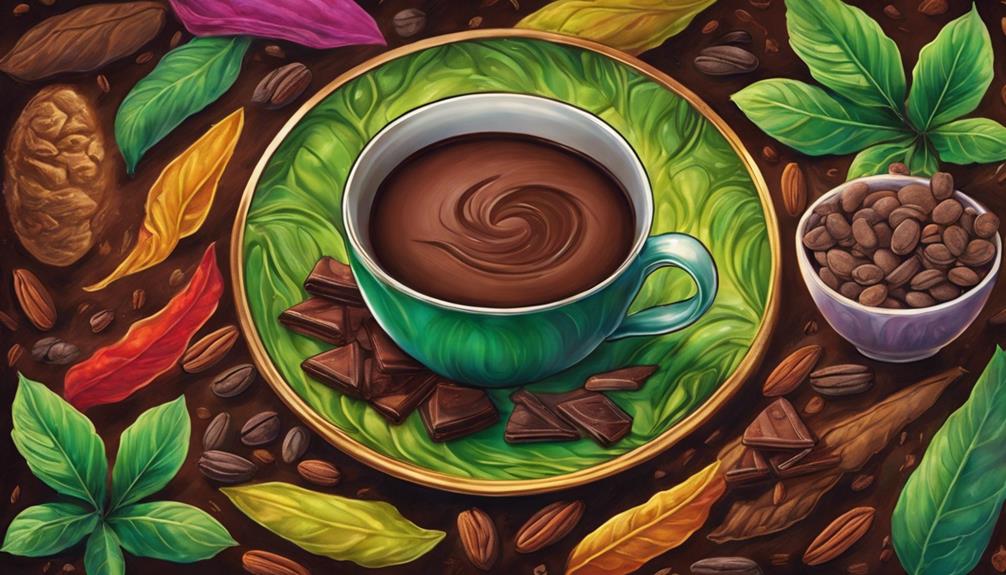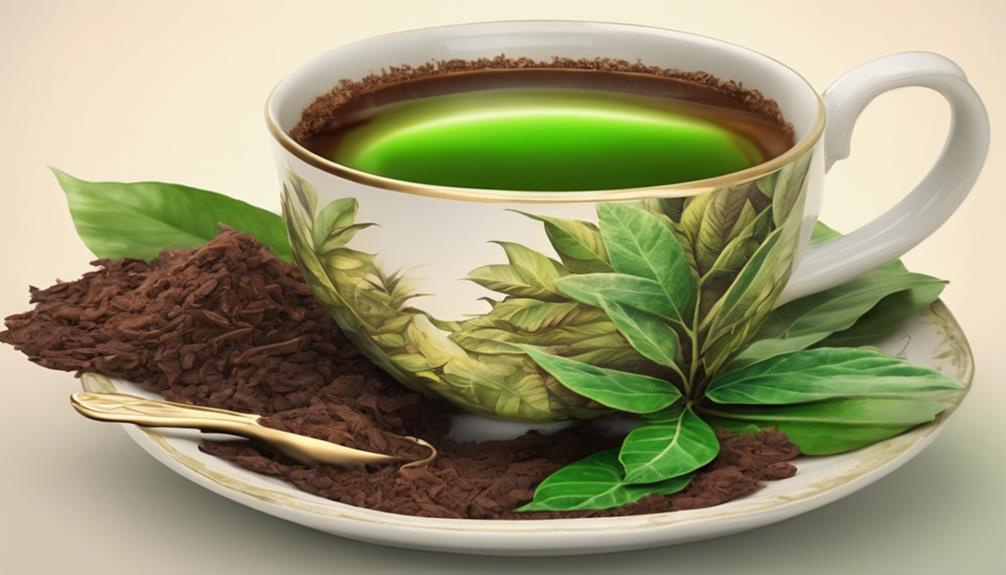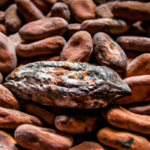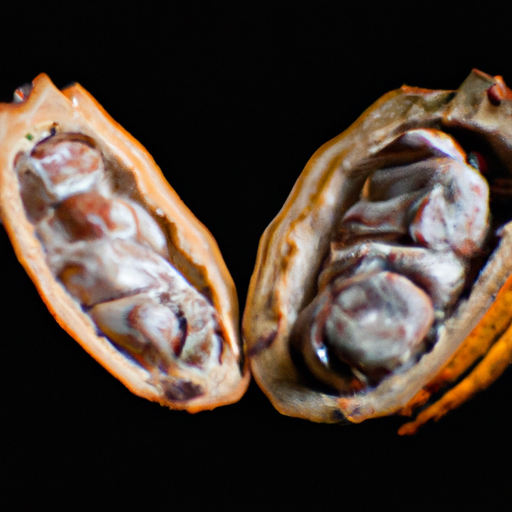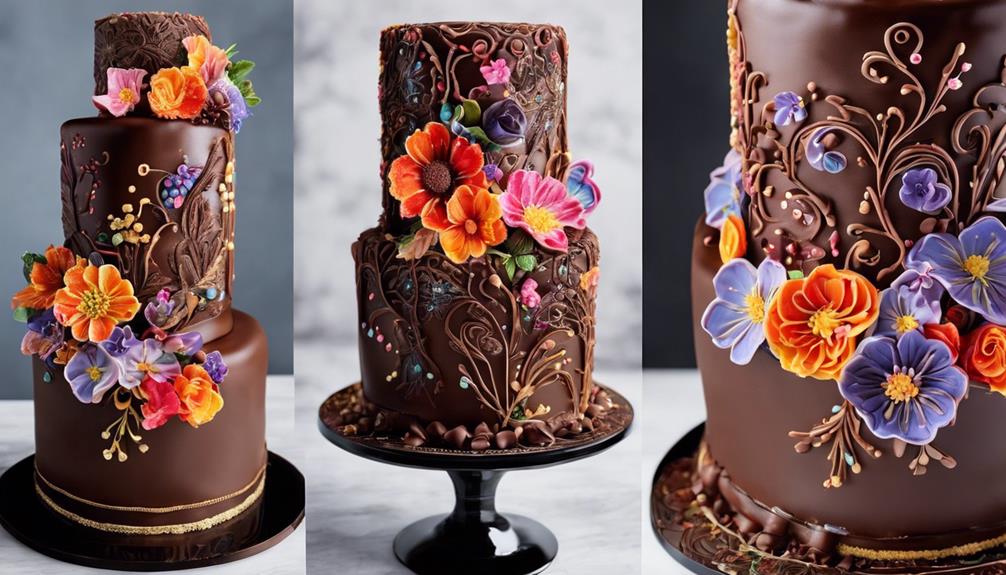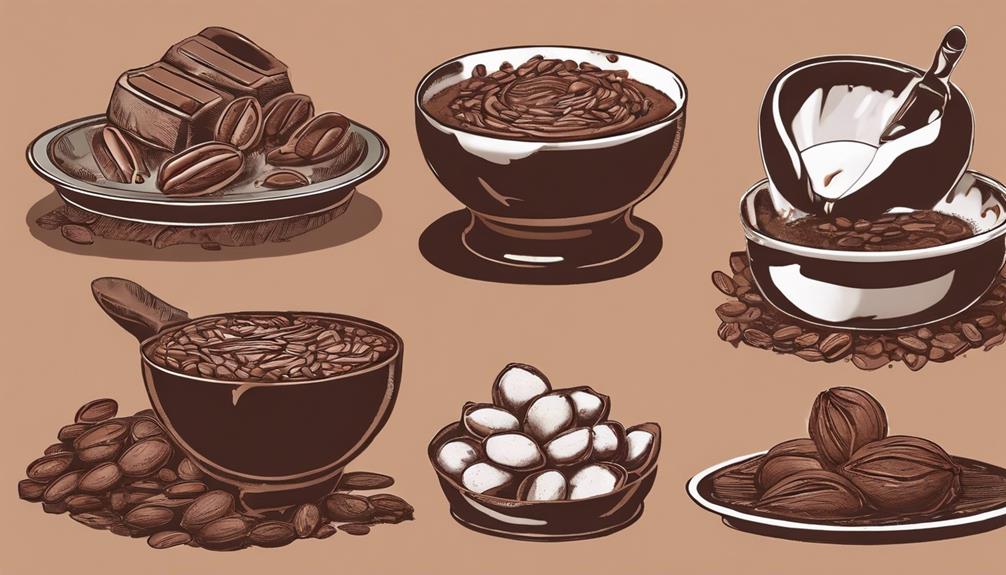Engaging in cacao consumption offers numerous health benefits. It can enhance heart health by reducing blood pressure, improving blood circulation, and decreasing oxidative stress. Moreover, cacao can enhance mood by increasing serotonin levels and fostering feelings of joy and wellness. The boost in energy from cacao is due to theobromine, providing lasting energy without the crash associated with caffeine.
Rich in antioxidants, cacao combats free radicals, supports cellular health, and strengthens the immune system. Improved circulation, cognitive function support, sleep quality enhancement, and additional benefits like better exercise performance round out the advantages of incorporating cacao into your routine.
Key Takeaways
- Boosts cardiovascular health with lowered blood pressure and improved blood flow.
- Elevates mood and happiness levels with natural antidepressants and serotonin enhancement.
- Provides sustained energy and focus without coffee crash for caffeine-sensitive individuals.
- Rich in antioxidants for cellular health, immune system support, and reduced chronic disease risk.
- Enhances cognitive function, memory, and alertness while improving sleep quality and relaxation.
Cardiovascular Health Boost
Drinking cacao can greatly improve cardiovascular health by lowering blood pressure and enhancing blood flow. Cacao, known for its rich and indulgent flavor, offers a plethora of health benefits beyond just satisfying your sweet tooth.
The antioxidants found in cacao play an essential role in reducing oxidative stress and inflammation, both of which are important factors in maintaining a healthy heart. By including cacao in your diet, you aren't only treating yourself to a delicious treat but also supporting your heart's well-being.
The flavonoids present in cacao have been linked to a decreased risk of heart disease and improved heart function. Additionally, regular consumption of cacao may contribute to better cholesterol levels, further promoting overall cardiovascular wellness.
Mood Enhancement

When it comes to mood enhancement, cacao can work wonders. Boosting serotonin levels and improving overall well-being are key benefits of consuming this delightful drink.
Boosts Serotonin Levels
Boosting serotonin levels through cacao consumption can lead to significant improvements in mood and overall well-being. Here are some reasons why cacao is beneficial for enhancing mood:
- Cacao drinking elevates serotonin levels, which are essential for regulating mood.
- Compounds like theobromine and phenylethylamine in cacao contribute to mood enhancement.
- The release of natural antidepressants triggered by cacao can boost overall mood and emotional balance.
- Enhanced feelings of happiness and well-being can result from elevated serotonin levels.
- Regular consumption of cacao as a drink can help alleviate stress and promote relaxation, leading to a better mood.
Improves Overall Well-Being
Enhancing overall well-being can be achieved through the mood-improving properties found in cacao. Cacao benefits include compounds like theobromine and phenylethylamine, which boost mood by increasing serotonin levels in the brain. This elevation in serotonin promotes feelings of happiness and relaxation, contributing to a sense of well-being. Additionally, cacao may have potential antidepressant effects due to its impact on neurotransmitters. By regularly consuming cacao, one can help reduce stress and anxiety levels, ultimately improving mental health. The mood-enhancing properties of cacao play an essential role in emotional balance, making it a delicious and beneficial addition to your daily routine.
| Cacao Benefits | |
|---|---|
| Boost Mood | Theobromine and phenylethylamine elevate serotonin levels. |
| Antidepressant Effects | Potential impact on neurotransmitters for improved mood. |
| Stress and Anxiety Levels | Regular consumption can help reduce stress and anxiety. |
Energy Increase
Drinking cacao can provide a sustained energy increase throughout the day, thanks to the natural stimulant Theobromine found in cacao. Theobromine in cacao offers a smooth and lasting energy boost, making it an excellent caffeine alternative for maintaining focus and sustained energy levels. Here are some key points to ponder:
- Theobromine in cacao provides a longer-lasting energy boost compared to caffeine.
- Cacao drinking can be a great alternative for those sensitive to caffeine jitters.
- The sustained energy from cacao helps improve focus and productivity.
- Regular consumption of cacao beverages can provide energy without the crash often associated with coffee.
- The energy increase from cacao can support your daily activities and keep you feeling refreshed throughout the day.
Experience the natural benefits of cacao for sustained energy and enhanced focus without the typical caffeine side effects.
Rich Antioxidant Content
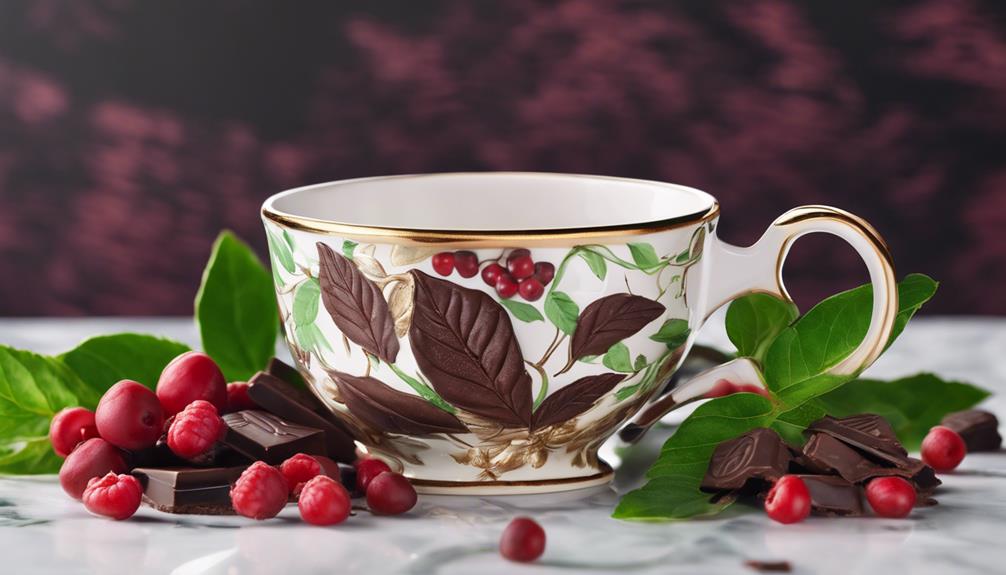
Filled with a strong assortment of antioxidants, cacao provides a natural and robust defense against free radicals, promoting overall well-being and energy. Cacao boasts an impressive antioxidant content, packing up to 40 times more antioxidants than blueberries. These antioxidants are crucial in combating free radicals, which can cause cellular damage and lead to oxidative stress.
The flavonoids present in cacao contribute greatly to its high antioxidant levels, enhancing its benefits for cellular health. Regular consumption of cacao can strengthen the immune system and support overall well-being due to its potent antioxidant properties. By incorporating cacao into your diet, you're actively engaging in the fight against inflammation and reducing the risk of chronic diseases.
Embrace the goodness of cacao's antioxidants to fortify your body and enjoy the long-term benefits they provide for your health.
Improved Circulation
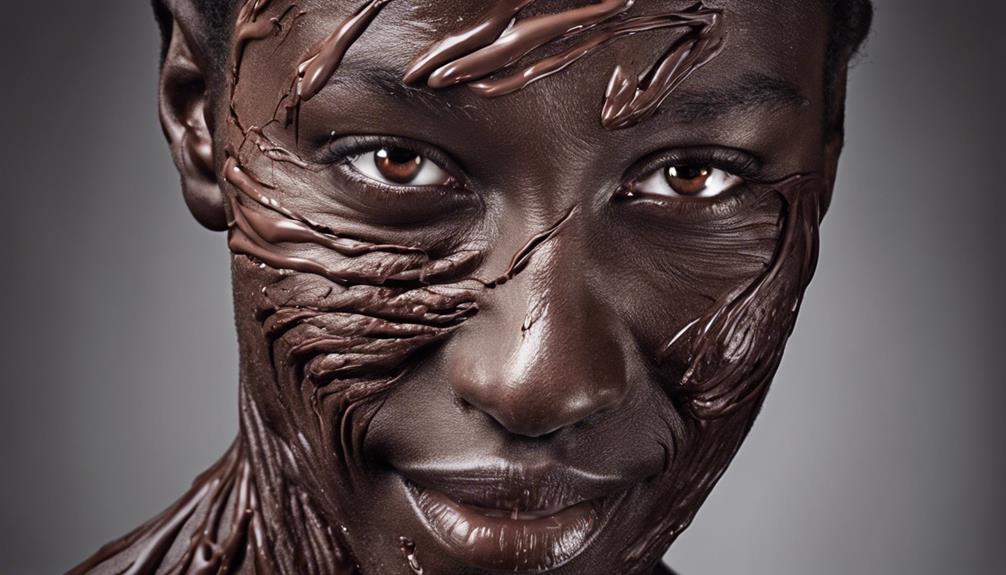
With its high flavonoid content, cacao has been shown to improve circulation by relaxing blood vessels and enhancing blood flow. When you drink cacao, you're giving your body a vital boost that supports your cardiovascular system. Here are some key ways in which cacao can help improve your circulation:
- Flavonoids: Cacao's essential components play an important role in relaxing your blood vessels, allowing for better blood flow.
- Lowering Blood Pressure: By improving circulation, cacao can help reduce the risk of cardiovascular diseases by lowering blood pressure.
- Nitric Oxide Production: Regular cacao consumption can increase nitric oxide levels, promoting vasodilation and enhancing circulation.
- Oxygen and Nutrient Delivery: Improved circulation means better delivery of oxygen and nutrients to all parts of your body.
- Antioxidants: The antioxidants in cacao support a healthy cardiovascular system, contributing to overall improved circulation and vascular function.
Nutrient Powerhouse
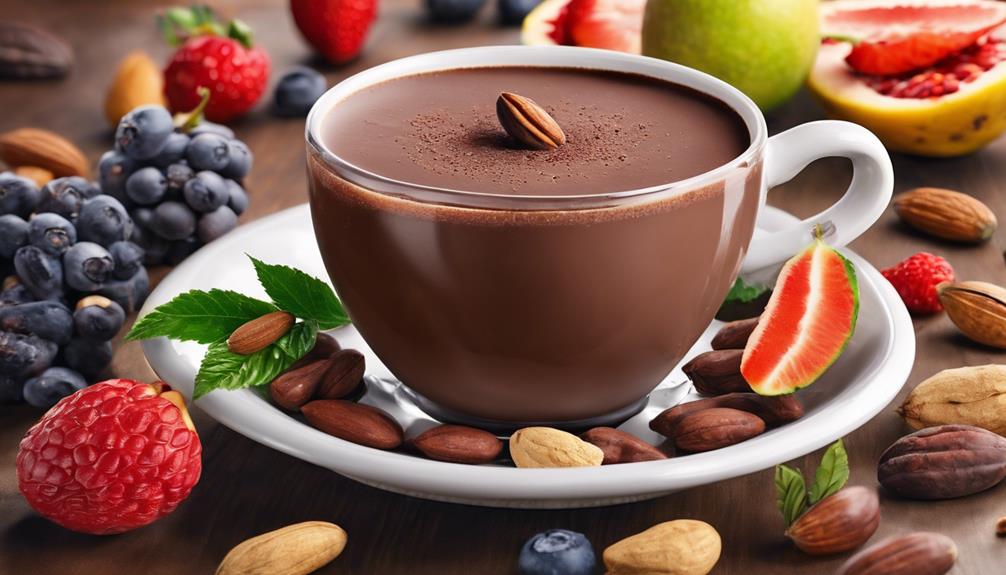
Cacao's nutrient profile packs a powerful punch, delivering high levels of antioxidants, essential minerals like magnesium and iron, and healthy fats. These antioxidants in cacao, such as flavonoids, are vital for combating oxidative stress in the body, promoting overall well-being. The presence of flavanols in cacao contributes to its high antioxidant content, protecting cells from damage and supporting a healthy immune system.
Furthermore, cacao is a rich source of plant-based iron, essential for transporting oxygen in the blood and supporting energy levels. It also serves as a valuable source of zinc, an important mineral for immune function and wound healing. Incorporating cacao into your diet can help meet your body's nutritional needs while indulging in a delicious treat.
Cognitive Function Support
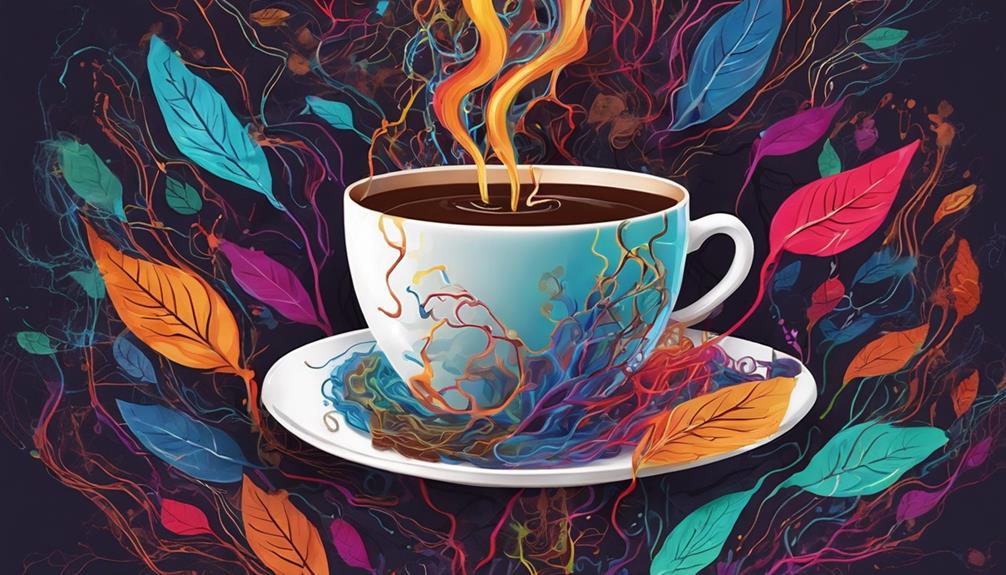
My daily intake of cacao has greatly improved my cognitive function through its abundant flavonoid content. Cacao, with its rich reservoir of flavonoids, has been a game-changer for my brain health. Here's how it supports cognitive function:
- Flavonoids: These powerful compounds in cacao enhance memory, focus, and overall brain health.
- Improved Attention Span: Regular consumption of cacao can boost attention span and cognitive performance.
- Antioxidants: The antioxidants in cacao protect brain cells from oxidative stress and aging, promoting long-term cognitive well-being.
- Theobromine Boost: The presence of Theobromine in cacao aids in increasing alertness and mental clarity, helping me stay sharp throughout the day.
- Enhanced Alertness: Cacao's properties contribute to heightened alertness, which is essential for improved cognitive function.
With these incredible benefits, cacao has become my go-to for supporting my cognitive function and ensuring my brain stays sharp and focused.
Sleep Quality Improvement
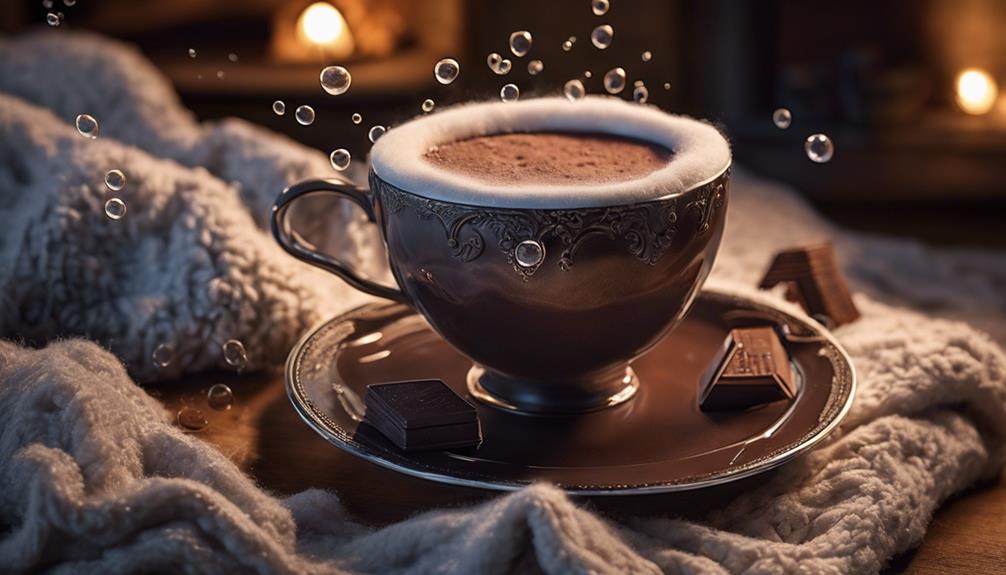
When it comes to improving sleep quality, drinking cacao can help calm the mind before bed.
This relaxation can promote better sleep by reducing nighttime stress.
The compounds in cacao, like theobromine, work to create a soothing effect that aids in achieving a restful night's sleep.
Calm Mind Before Bed
Drinking cacao before bedtime can greatly enhance the tranquility of the mind and contribute to a more peaceful and restorative sleep experience.
Cacao contains theobromine and tryptophan, which are compounds known for their calming effects, helping to reduce stress and promote relaxation before sleep.
The natural neurotransmitters released by cacao can also aid in regulating sleep patterns, leading to improved sleep quality overall.
Incorporating cacao into your evening routine can create a soothing ritual that prepares your mind and body for a restful night's sleep.
Relaxation for Sleep
Enhancing sleep quality can be achieved through the promotion of relaxation, a key factor influenced by the consumption of cacao. Cacao contains compounds like theobromine and tryptophan, which play a significant role in improving sleep patterns. These components help in calming the mind and body, preparing them for a restful night.
The theobromine in cacao acts as a natural relaxant, aiding in inducing relaxation before bedtime. By incorporating cacao into your evening routine, you can support a healthy sleep cycle. Embracing the soothing effects of cacao can contribute to a more peaceful and rejuvenating sleep experience, ensuring you wake up refreshed and ready to tackle the day ahead.
Nighttime Stress Relief
During nighttime, finding effective stress relief methods is essential for improving sleep quality. When it comes to nighttime stress, incorporating cacao consumption into your routine can be a game-changer. Here are some reasons why cacao can help with nighttime stress relief and improve your sleep quality:
- Cacao consumption before bedtime can reduce stress levels and promote relaxation.
- Compounds like theobromine and tryptophan in cacao aid in improving sleep patterns.
- The calming effects of cacao can help alleviate nighttime stress and anxiety.
- Cacao triggers the release of natural mood-enhancing compounds, promoting calmness.
- Incorporating cacao into your nighttime routine can offer a natural solution for stress relief and better sleep.
Exercise Performance Enhancement

Improving exercise performance can be achieved through the consumption of cacao, thanks to its endurance and stamina-boosting effects. When we consume cacao, the flavanols present in it play a pivotal role in enhancing physical performance by influencing nitric oxide levels in our bodies. This, in turn, leads to improved endurance and stamina during workouts.
Athletes looking to push their boundaries may find incorporating cacao into their pre-workout routine beneficial for achieving enhanced results. Studies have shown that cyclists who consumed dark chocolate could cover longer distances while using less oxygen, showcasing the performance-enhancing properties of cacao.
Whether you're into cycling, running, or other sports activities, cacao consumption could give you that extra edge to excel in your physical endeavors. So next time before you hit the gym or go for a run, consider adding a bit of cacao to your routine and feel the difference in your exercise performance.
Anti-Aging Properties

Cacao's high levels of antioxidants actively combat free radicals, effectively reducing visible signs of aging like wrinkles and fine lines. The epicatechin present in cacao plays an important role in promoting youthful gene expression and enhancing blood flow, contributing to its anti-aging properties.
Regular consumption of cacao not only aids in delaying age-related cognitive decline but also helps in preventing neurodegenerative disorders. The flavonoids found in cacao are essential for shielding the skin from sun damage, which is significant for maintaining a youthful appearance.
Moreover, cacao's anti-inflammatory characteristics are beneficial for overall skin health, diminishing the effects of aging. By incorporating cacao into your diet, you aren't only indulging in a delicious treat but also providing your body with the necessary nutrients to combat the signs of aging effectively.
Frequently Asked Questions
What Does Drinking Cacao Do for You?
Drinking cacao uplifts my spirits, boosts energy, and supports heart health. It enhances cognitive function, fights inflammation, and improves skin health. Cacao is a delicious way to nourish both body and mind.
Is It OK to Drink Cacao Every Day?
Drinking cacao every day is alright for me. It keeps me feeling good and satisfied. It's a little treat that I look forward to daily. So, yes, it's definitely a part of my routine!
Is Cacao Really a Superfood?
Yes, cacao is truly a superfood. It's packed with antioxidants, iron, magnesium, and mood-boosting properties. Consuming cacao supports heart health, improves circulation, and provides a natural energy boost. It's a fantastic addition to my daily routine.
Why Does Cacao Make Me Feel Good?
Cacao makes me feel good because it boosts my mood naturally. It's like a warm hug for my mind, releasing feel-good chemicals and antioxidants that help me relax and feel happier, promoting a sense of well-being.
How Does Cacao Drinking Provide Energy Without Caffeine?
Cacao drinking provides a natural energy boost without caffeine due to its low cacao powder caffeine content. Theobromine, a compound in cacao, stimulates the central nervous system, dilates blood vessels, and increases heart rate, resulting in a gentle energy lift without the jitters associated with caffeine.
Conclusion
Drinking cacao can be like giving your body a warm hug from the inside out. Just like a cozy blanket on a chilly night, cacao can help boost your heart health, mood, energy, and more.
So next time you're looking for a delicious and beneficial drink, reach for some cacao and feel the love it brings to your body and mind.

